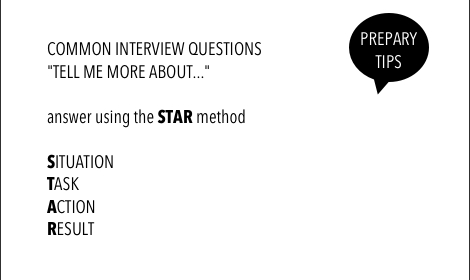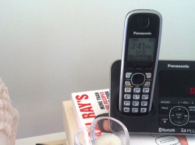One of the most common questions that you’ll be asked in an interview is something like this:
Tell me more about… [insert experience or job here]”
Why it’s important:
This question is one of the most important ones in any job interview. Often times (good) interviewers will ask it more than once, about many different aspects of your experience. Without knowing about your past experiences, skills, and results, how will anyone know if you’re going to be great for the job?
Sure, someone can ask “Are you organized?” and I can say “Yes” but then they’re going to have to just take my word for it. If they ask instead “I see you supported 3 executives at once – can you tell me more about that?” and then I go into exactly how I kept myself organized it’s going to be a lot more compelling.
How to answer

The key to answering this question well is using the STAR method. I actually just learned about it myself when I was describing the advice I usually give clients (on how to answer this question) and my coworker Tina informed me it had a name (and an acronym!)
Here are the basics of the STAR method. Let’s use the example above to walk through it.
Situation
First, you lay the groundwork and describe the situation. Remind yourself that your interviewer doesn’t know the nuances of your environment so it’s important to be clear and succinct. Give only the background that is absolutely necessary (if I went on an interview tomorrow this would probably be my weak area! I can talk forever…) In the example we’re using the situation would be:
In my role at [company] I was responsible for supporting 3 high-level executives. They were the CFO and the CIO of the company and both had very hectic schedules and complex needs.
Task
Next it’s time to describe the task at hand. What exactly did you have to go out and do in this situation? If you were being measured on concrete metrics or results, it’s always good to add that detail as well (i.e. I needed to achieve growth of 150%). But in this example the task might sound like:
My goal each week was to ensure that the executives felt supported, organized, and had everything they needed to get through their day. The CFO often needed materials put together for meetings using Excel + PowerPoint which I was also responsible for.
Action
Now onto the action itself. What did you actually do to execute on the task? This is your prime opportunity to show off your capabilities and basically prove that you can make sh*t happen.
If you had other key partners in the company who helped or collaborated, it’s good to mention that here but don’t sell yourself short on your contribution to the work.
In the example we’re using this could be the fact that you have a robust organization system (describe it in detail), or the fact that you print off the following day’s schedule each evening and have it ready to go each morning. The list could go on for a while in this example, but this part of the STAR method is all about what do.
Result
Last, and most importantly comes the result. Interviews don’t want to hear fluff – they want to talk concrete accomplishments. How did that thing you just described benefit your team? The company?
The more metrics or facts you can put around the results portion of your answer, the better. “I saved the company $10,000 in expenses” or “I launched the product 2 months ahead of schedule” or “The presentation I put together got brought to a senior leadership meeting the next week” or “My idea of [x] got implemented”.
You get the picture – it’s all about the outcome!
–
I really do think the STAR method gives a great and easy framework to answer an interview question really, really, well. When you break it down this way, it makes things simple and helps you not go down a babbling path about things that don’t matter.
PS – Need help on interview prep? I’d love to work with you!





